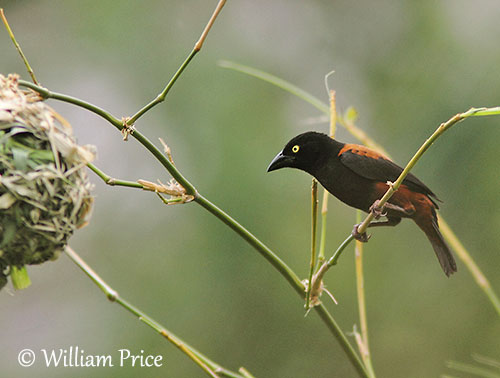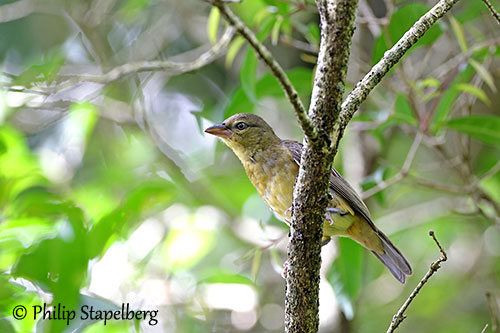
Fr: Tisserin noir
Ang: Vieillot's Black Weaver
All: Vieillotweber
Esp: Tejedor de Vieillot
Ita: Tessitore nero di Vieillot
Nd: Fluweelwever
Sd: vieillotvävare
Photographers:
Jean-Claude Billonneau
Photographe-témoin de la Beauté du Monde
Ken Havard
My Bird Gallery & Flickr gallery 1 & Flickr gallery 2
William Price
PBase-tereksandpiper & Flickr William Price
Dubi Shapiro
Dubi Shapiro Photo Galleries
Philip Stapelberg
GALLERY
Text by Nicole Bouglouan
Sources:
HANDBOOK OF THE BIRDS OF THE WORLD Vol 15 by Josep del Hoyo-Andrew Elliot-David Christie - Lynx Edicions – ISBN: 9788496553682
BIRDS OF AFRICA SOUTH OF THE SAHARA by Ian Sinclair and Peter Ryan - Princeton University Press Princeton and Oxford - ISBN: 0691118159
BIRDS OF THE GAMBIA AND SENEGAL by Clive Barlow and Tim Wacher – Helm Field guides – ISBN: 0713675497
Nesting Behavior of the Chestnut-and-Black Weaver
Vieillot's Black Weaver
Ploceus nigerrimus
Passeriformes Order – Ploceidae Family
INTRODUCTION:
The Vieillot's Black Weaver is named after its black plumage. The species is found in E and C Africa, and two subspecies share the range. They were formerly described as distinct species. They are known to interbreed in S Nigeria where their ranges meet.
The Vieillot's Black Weaver frequents forest clearings, wooded areas and savannas with tall grass, and it is often seen in villages. It feeds primarily on various insects, but it also takes seeds, fruits, berries and nectar from flowers. It is gregarious and often joins mixed-species foraging flocks.
This species breeds colonially like numerous Ploceidae. The male is polygynous and may breed with up to five females. It builds an oval nest and displays at the entrance below the woven structure. The nesting duties are mainly performed by the female.
The Vieillot's Black Weaver is described as abundant, except in Gambia where it is rare. Often associated with humans, this species is not globally threatened.
DESCRIPTION OF THE BIRD:
Biometrics:
Race P.n. nigerrimus: Length: 17 cm – Weight: 21-44 g
Race P.n. castaneofuscus: Length: 17 cm – Weight: 24-39 g
The Vieillot's Black Weaver male of nominate race “nigerrimus” has black plumage overall.
The bill is black. The eyes are yellow. Legs and feet are greyish to pinkish-brown.

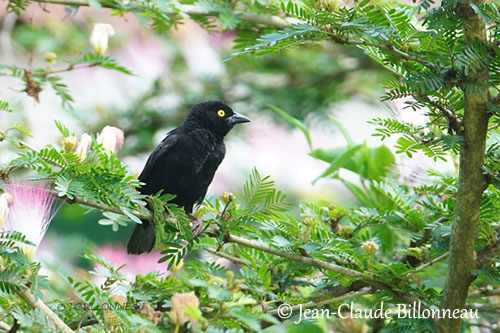
The female has dull greenish upperparts. Crown and nape show narrow, weak dark streaks, but this pattern is darker and broader on mantle and back. The rump is uniformly greenish. The tail is dark brown-grey.
On the dark brownish-grey upperwing, the flight-feathers show narrow olive-green edges, whereas the wing-coverts have pale buffy edges.
On the underparts, chin and throat are pale yellow, and we can see a broad, buffy breast band (sometimes more olive). Flanks, thighs and undertail-coverts are buff, sometimes with olive wash on flanks. The belly is dull yellow to olive.
On the head, the lores are greyish. The cheeks are buffy like the weak supercilium. Rest of face and neck sides are dull greenish. Crown and nape are narrowly streaked dark.
The bill is dark grey with horn-coloured lower mandible. The eyes are pale brown. Legs and feet are brown.
The juvenile resembles female but forehead and crown are unstreaked. The wing-coverts have buffy edges. The underparts are buffier.
The eyes are dark grey first and then brown, before becoming yellow in males.
SUBSPECIES AND RANGE:
The Vieillot's Black Weaver has two subspecies.
P.n. nigerrimus (described above) is found in Extreme SE Nigeria to Uganda, W Kenya, Angola and DR Congo.
P.n. castaneofuscus is found in Sierra Leone to S Nigeria.
There is a narrow hybrid zone in S Nigeria where the ranges of both subspecies meet.
The male of this race, also named Chestnut-and black Weaver, has black plumage, but upperparts, belly and undertail-coverts are chestnut. The bare parts are similar to nominate race.
The female has brownish upperparts and rufous rump. The underparts are buffy-yellow with rufous tinge on flanks. The juvenile resembles female with some differences like in nominate race.
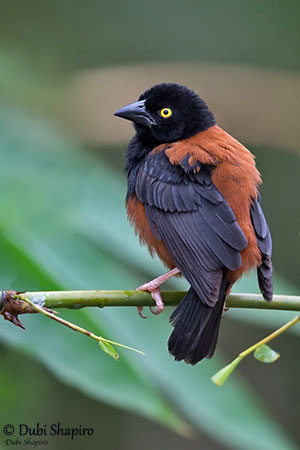
HABITAT:
The Vieillot's Black Weaver frequents forest clearings and edges, secondary growths, wooded areas and savannas with tall grass. It is often seen in villages. However, it is rarely found in unspoiled forest.
The species is visible between 1,000 and 2,000 metres of elevation.
The Chestnut-and black Weaver frequents the same type of habitat, but it is also found in ponds and swamps. This race is visible below 800 metres of elevation.
CALLS AND SONGS: SOUNDS BY XENO-CANTO
The Vieillot's Black Weaver gives a harsh “chak” both in alarm and defence. We can hear irregular series described as “tsuk-way-tsik” or “tsik-tsuk-tsik”. Other sounds such as a whistled “sweet” and an upslurred “way-yee” are also heard.
The song is a chattering phrase. During territorial defence and courtship displays, a short song described as “chrrr-szee-zuit” is uttered.
The Chestnut-and black Weaver produces a typical weaver wheezing stream of chattering raspy notes. We can hear a short “tyup” or “jup” and “zeet” interspersed with chattering notes. It also produces some whistled notes such as “weeyoo” or “woo”.
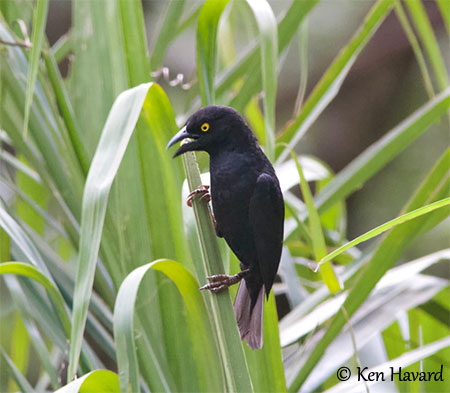
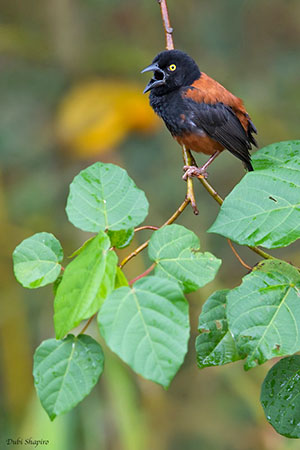
BEHAVIOUR IN THE WILD:
The Vieillot's Black Weaver feeds primarily on insects such as grasshoppers, winged ants and termites, caterpillars and butterflies. But its diet also includes seeds, fruits, berries and nectar from flowering trees.
The flying insects are usually caught on the wing.
The nectar is taken by probing in flowers, and pollen can be seen on the plumage of the birds.
The Vieillot's Black Weaver is a gregarious species that often joins mixed-species flocks of insect-eaters foraging in more open areas.
The roosts often gather several Ploceidae species, and among them, the Village Weaver (P. cucullatus).
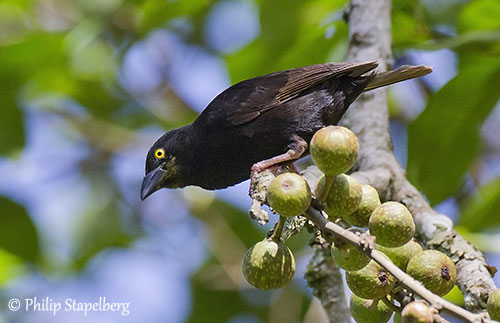
The males of both subspecies are polygynous with up to five females in male’s territory.
They nest in colonies and the breeding activities are related to rainfall. The colonies are established in trees, reeds, bulrushes, papyrus or bamboos. Several nests (usually three) are usually built in one male’s territory. They are part of a large colony of dozens or hundreds of nesting Ploceidae.
The oval nest is built by the male with woven strips of palm leaves or grass. The soft lining is made by the female which performs most of the nesting duties.
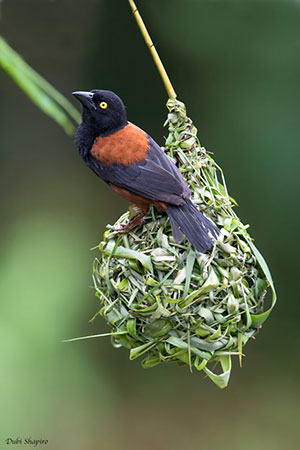
The male defends the territory with an aggressive dance, and it adopts a threat posture with ruffed head feathers while the bill is slightly open.
During the displays, when females visit the colony, the male sings and hangs below the nest entrance while its wings are quivering and the tail raised away from the nest.
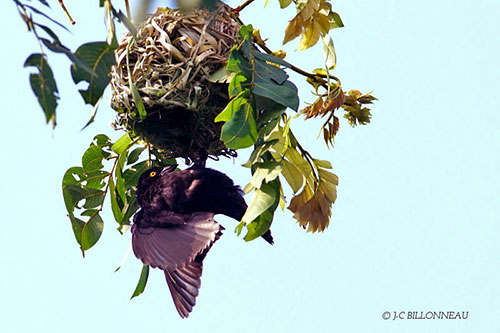
Both subspecies are resident, but movements related to foraging areas and food availability are reported.
The flight is usually active while foraging, but they often fly only over short distances.
REPRODUCTION OF THIS SPECIES:
The breeding season varies depending on the range.
Males are polygynous with up to five females in male’s territory. Usually, two clutches per season are laid. If a brood is lost, the female lays a replacement clutch.
The Vieillot's Black Weaver is colonial. The nests are built in bulrushes, tall elephant grass (Pennisetum purpureum), palm, bamboo or tree. It is placed 1-2 metres above water or 6-8 metres above the ground when in tree.
From some observations, some colonies may be established around an active nest of African Harrier Hawk, or associated with human habitations, probably for protection.
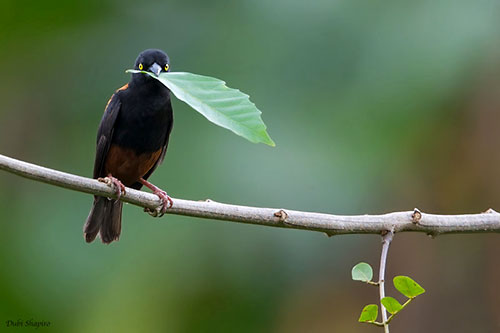
The nest is built by the male, an oval structure of about 125 mm wide and 95 mm high. The diameter of the entrance is about 40 mm. The entrance is below the nest and without tunnel.
The male weaves strips of palm leaves or grass, and nest-building lasts usually 9 hours. The female adds a lining of soft materials inside.
The Vieillot's Black Weaver often breeds in mixed colonies with the Village Weaver (P. cucullatus).
The female lays 2 pale blue eggs, sometimes with some purple markings. She incubates alone during 14 days (in captivity). The chicks are fed first by the female, but later, the male can participate in nesting duties. The nestling period lasts 17 days (in captivity). Information of the behaviour in the wild is required.
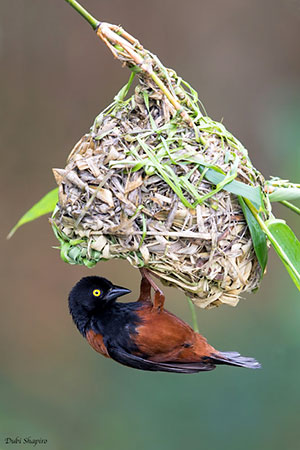
The nests are parasitized by the Deiderik Cuckoo in Ghana and Nigeria, and probably in other regions.
PROTECTION / THREATS / STATUS:
The Vieillot's Black Weaver of nominate race is described as common to abundant, although it is patchily distributed.
The Chestnut-and black Weaver is abundant too, but rare in Gambia. It is expanding its range thanks to the deforestation.
Both subspecies are not globally threatened, and their populations are suspected to be stable. The Vieillot's Black Weaver and the Chestnut-and black Weaver are currently evaluated as Least Concern.
